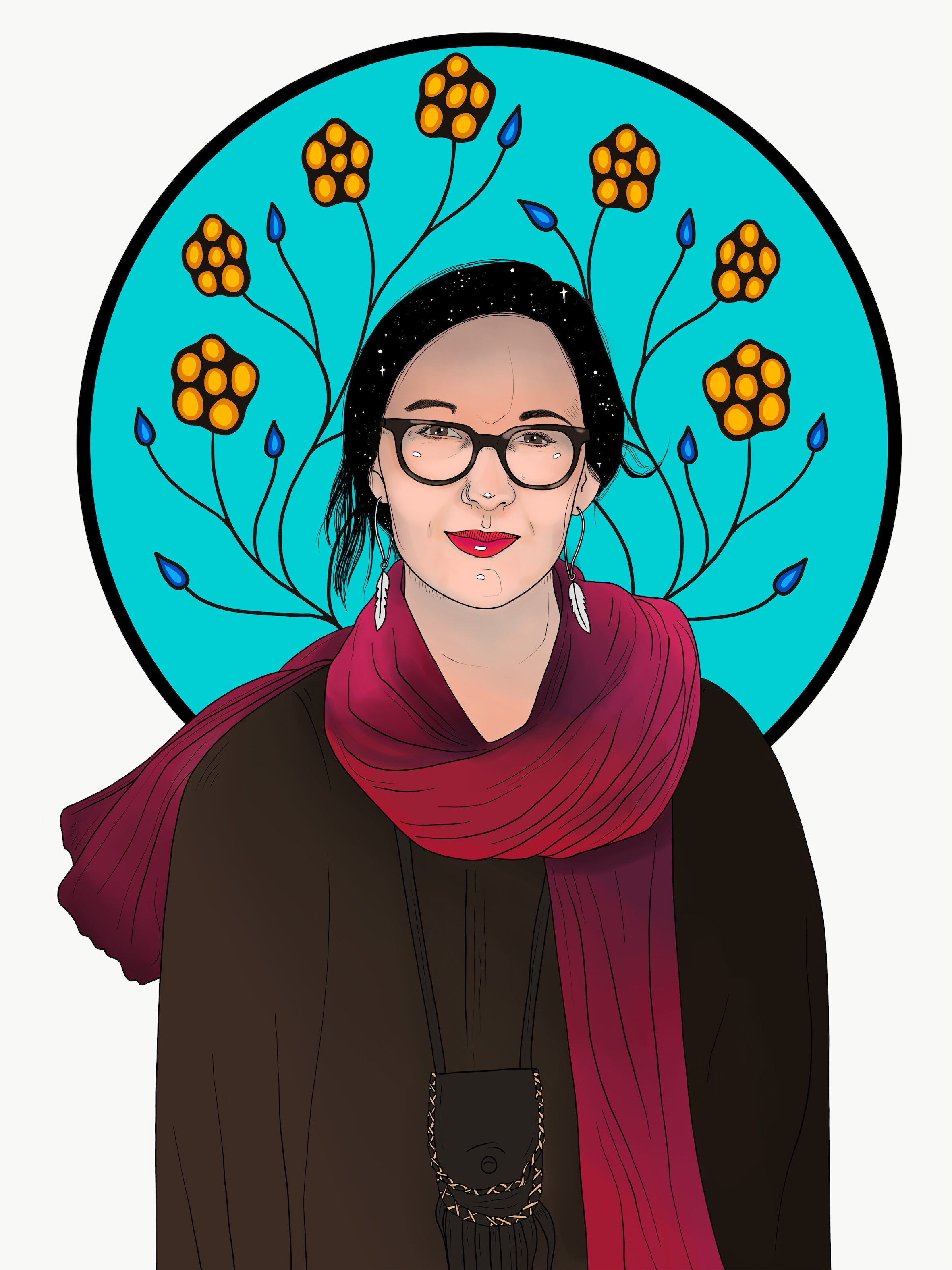The following is a sample profile from the book Holy Troublemakers & Unconventional Saints by Daneen Akers.
Kaitlin Curtice
Kaitlin Curtice hears the sound of quiet footsteps and looks up to see her five-year- old son making his way down the stairs in his pajamas. She makes space for him on the couch, and he climbs up next to her. She loves these morning snuggles.
“Mno waben,” Kaitlin whispers in his ear, as she hugs him. Mno Waben sounds like “minnow-wah-bin,” and it means “Good Morning” in the language of the Potawatomi people.
“Mno waben, Mama,” he whispers back. She feels a deep gladness in her heart, hearing his morning greeting in Potawatomi.
The Potawatomi words all have actions and ideas embedded into them. Mno Waben translates to, “It is good when things become visible in the light,” a fitting idea for the time of day when the sun’s rays begin to touch the land, the animals, and the people of Turtle Island, the term that many Native people use for North America.
Illustration by Chief Ladybird
Kaitlin had only begun learning more about her Potawatomi heritage, culture, and language a few years before; even though she was born on Potawatomi land in Shawnee, Oklahoma and has always been an enrolled member of her tribe. Generations of Kaitlin’s Native American relatives have lived in the U.S.; they knew they needed to minimize their Potawatomi identity simply to survive. Kaitlin’s mother was of European heritage, and when Kaitlin was nine, her parents divorced. Afterward, Kaitlin had little contact with her Potawatomi relatives and tribal land. “I didn’t know we had stories. I didn’t know we had a language,” she says. “We knew we were Potawatomi, but no one talked about it. I realize now this was the effect of forced assimilation over time.”
As a young girl, growing up in the Baptist church and trying to make sense of the world after her parent’s divorce, Kaitlin became the best Christian girl she could. In school, she carried an extra Bible in her backpack, just in case a schoolmate needed one. She memorized Holy Scriptures. She didn’t ask questions in Sunday school—at least not out loud. She even posed with her Bible for her fifth-grade school portrait. “I was the poster child for what I thought a good Christian girl should be,” she says.
As she got older though, Kaitlin began to be curious about her Potawatomi heritage. As she moved into adulthood, marriage, and motherhood, she started to learn more about her roots, and she began to learn the Potawatomi language and history.
It wasn’t easy to reconcile her Christian faith with the grim reality of how the vast majority of American Christians had treated Native people. Her Potawatomi ancestors had been forced to leave their lands in the Great Lakes region in 1838, at gunpoint, in a march we now call the “Trail of Death” because so many people died along the way. The Trail of Death was just one of many such forced removals of Native people by European settlers.
One day, while hiking through a tree-lined trail at Sweetwater Creek near her current home in Atlanta, Georgia, Kaitlin felt God affirming her as a Potawatomi woman. “God told me that I was Potawatomi. Growing up, I knew that, but it was head knowledge. In that moment while hiking next to a giant river, God sent what was head knowledge into heart knowledge. It became a different type of knowledge altogether.”
With her newfound appreciation for herself as a Potawatomi woman and as a new mother wanting to share her full heritage with her sons, Kaitlin immersed herself in Potawatomi culture. She learned about the Potawatomi origin story, which begins with Skywoman falling down from Skyworld through a hole in the sky.
The animals see the shaft of light from the hole, and they see that Skywoman is falling towards the water. Her fall is broken by a flock of geese that see that she is in danger. The geese hold her up on their wings until they can decide what to do next. Far below, a giant turtle offers to let her rest on his back. The animals can see that the woman needs land to live on. With the help of several animals, mud is retrieved from the bottom of the waters so that land can be built on Turtle’s back. Skywoman is so grateful for the help of the animals that she begins dancing her thanks. As she dances, the land spreads all across the turtle’s back. As Skywoman fell, she grasped a bundle of seeds and roots in her hands from the Tree of Life. She plants these seeds in her new home. Soon plants, trees, and all manner of living things grow. This collective effort of geese, Skywoman, the turtle, the animals, and the riverbed brought about life on Turtle Island. And this is why many Native people, including Kaitlin’s tribe, call North America “Turtle Island.” It’s a story of connectedness—of people, animals, and land coming together.
“Learning our Potawatomi origin story answered so many questions for me,” Kaitlin says. “It even helped me understand the Bible better. I’d always thought the Genesis origin story had to be read completely literally, but I realized that this is what oral storytelling cultures do. We look around and wonder how something got there, and then we tell a story about it. Our cultural stories are all inter-connected and fit together like a big, beautiful puzzle. That’s why we need all of them.”
Today Kaitlin works as an author and speaker helping to share the stories that call all people to work for peace and restoration. But working together for a common vision where all people belong and can flourish means having a shared understanding of the past, even when it’s painful to remember. Because she grew up in the Christian church and knows that world so well, Kaitlin is aware that she is in a unique position to remind her family and friends at church of the way Native peoples all over the world have been treated by many Christians.
For decades, Potawatomi children and other Native American children were forced to live away from their families in boarding schools that were meant to “Kill the Indian, Save the Man.” Native American children were banned from speaking their languages or practicing their cultures or religions in any way. They had to cut their hair short and couldn’t wear traditional clothing. They had to practice the Christian religion, and they rarely saw their parents. The Bible was used to justify these programs that are now seen as cruel and unjust. The effects of these policies are still felt today among Native populations. The conditions under which they were forced to live have resulted in their high rates of poverty. Understandably, they also tend to mistrust the government.
In many ways, Kaitlin’s work comes back to that simple morning greeting that she loves to hear her sons say: Mno waben, or, it is good when the light shines on things. It’s emotionally hard to reflect on these painful parts of the past. We might even prefer to forget what really happened to Native people. But Kaitlin knows that acknowledging the truth, even if it’s hard, is the only way healing can begin.
As soon as Kaitlin began speaking and writing about her identity as both a Jesus-follower and a Potawatomi woman, she began to have a harder time, especially in church. Many Christians preferred her to be silent about her identity as a Native person. “It’s time for us as a collective to acknowledge what’s been done to Native peoples at the hand of the church,” she says. “It’s time to remember that everyone belongs. As long as the church only wants what is White in me and not what is Native in me, there’s still more work to be done.”
Recently Kaitlin got a tattoo on her left arm that was designed by another Native woman. “My tattoo is a symbol of the healing of a people,” Kaitlin says. “It carries a dream for all of us as Indigenous people, but the only way to get there is through. So I light my tobacco, my sage and sweetgrass, and pray. I pray, Migwetch (thank you) Great Father, Creator, Great Spirit. And slowly but surely, I find my way back. Slowly but surely, I find a way to love.”
What story about the beginning of the world have you grown up with?
Glossary Terms
Assimilation
The process of absorbing another culture’s ideas, customs, and traditions; sometimes done voluntarily and sometimes as a matter of survival.
Christian/Christianity
A person who practices Christianity, the Abrahamic Religion based on the teachings of Jesus, a first-century Jewish teacher. While there are many different types of Christians who vary widely in belief and practice, all find the life and teachings of Jesus to be of central importance.
Culture
The customary beliefs, traditions, art, food, dress, and ideas of a particular people and place.
Genesis Origin Story
A story in the very beginning of the Hebrew Scriptures and Christian Scriptures; tells the story of God creating the heavens and the earth and all living things, including human beings. There is a similar origin story, too, in the Quran.
Indigenous
The original or Native people in a region or country. Indigenous people are descended from the original inhabitants of the land they live on. In the U.S., Indigenous people are usually called “Native Americans.” In Canada, they are called “First Nations” people. Today there are an estimated 370 million Indigenous people in 90 countries who speak 7,000 languages.
Migwetch
The word for “thank you” in the Indigenous language of the Ojibwe and Potawatomi people (and related language groups) of the U.S. and Canada.
Origin Story
A story about a beginning; the story told by a culture, religion, country, or other entity about how their world began; origin stories inform the identity and motivations of an individual or people group.
Potawatomi
Native American tribe originally from the eastern woodlands and Great Lakes region; means “fire-keepers,” which was their role among three neighboring tribes that worked closely together.
Skywoman
A sky goddess in the Origin Story of several Indigenous tribes who fell from the sky; along with several animals, birds, and a great turtle, created Turtle Island with mud from the deep waters.
Trail of Death
The forced removal in 1838 of the Potawatomi people from their Ancestral Lands; on their way to new land chosen by the government, more than 40 people died, most of them children. Many such forced removals happened during this era, the most well-known being the Trail of Tears when Cherokees were forced to leave their ancestral lands for a reservation in present-day Oklahoma.
Turtle Island
The name for North America that many Native American and First Nations people use.
Read another sample chapter from the Holy Troublemakers & Unconventional Saints book by Daneen Akers.



